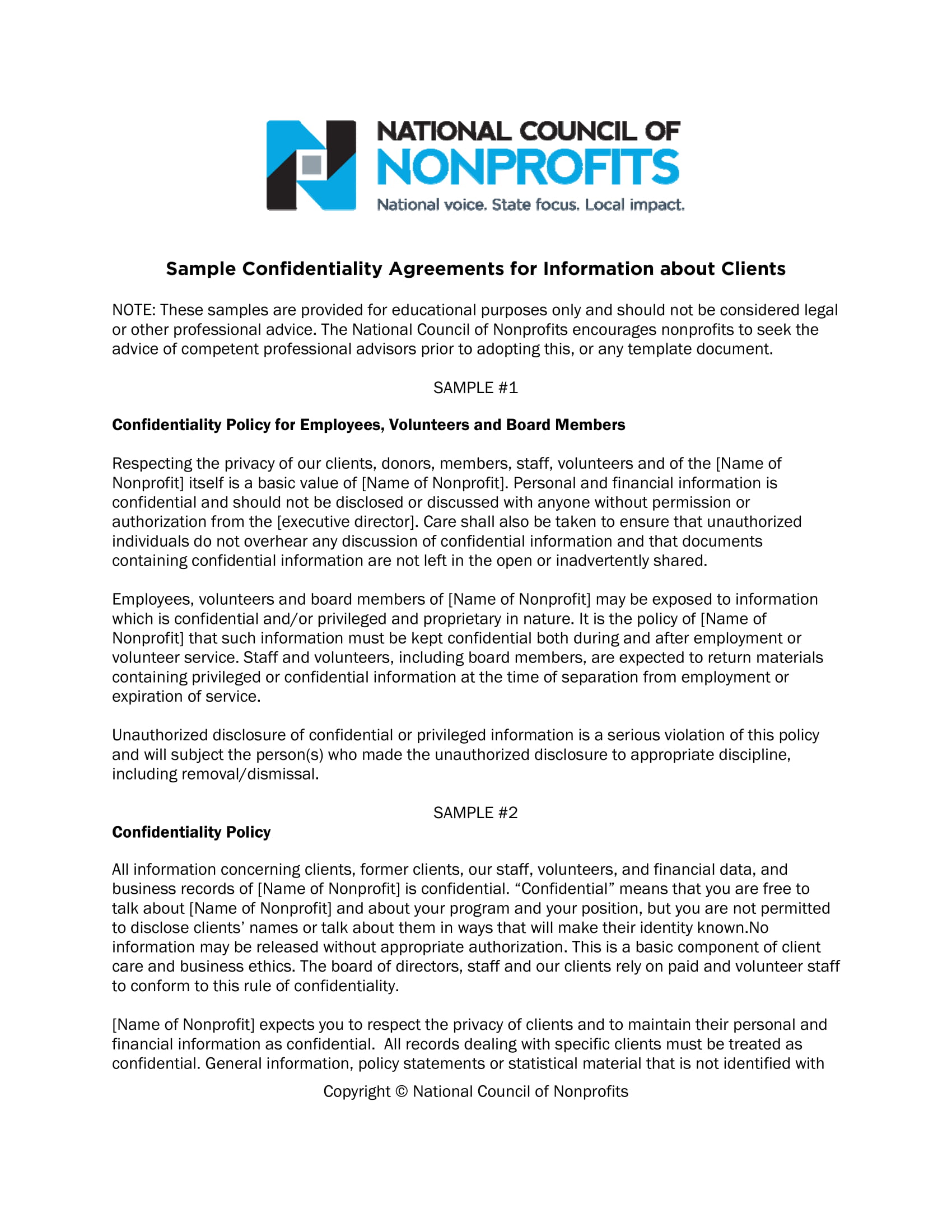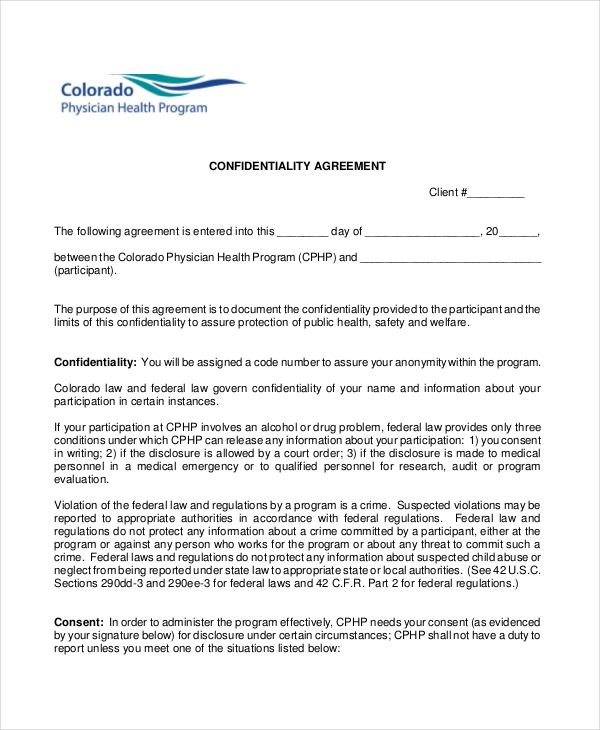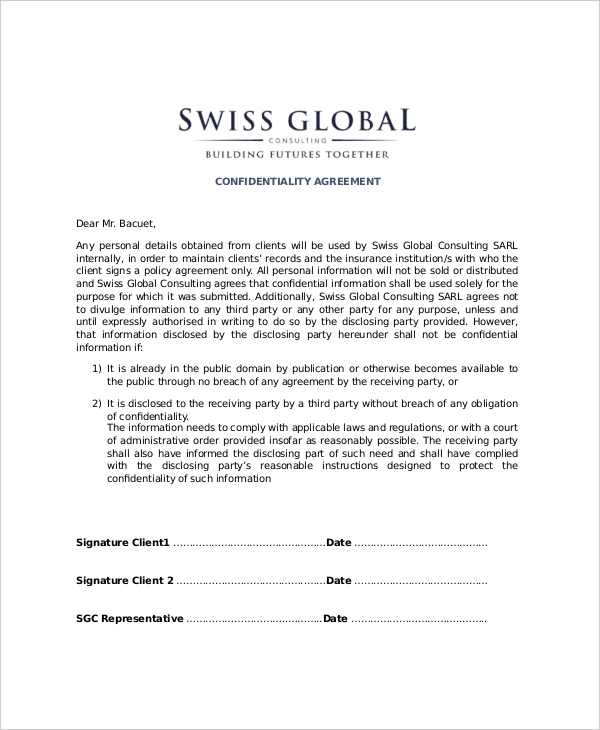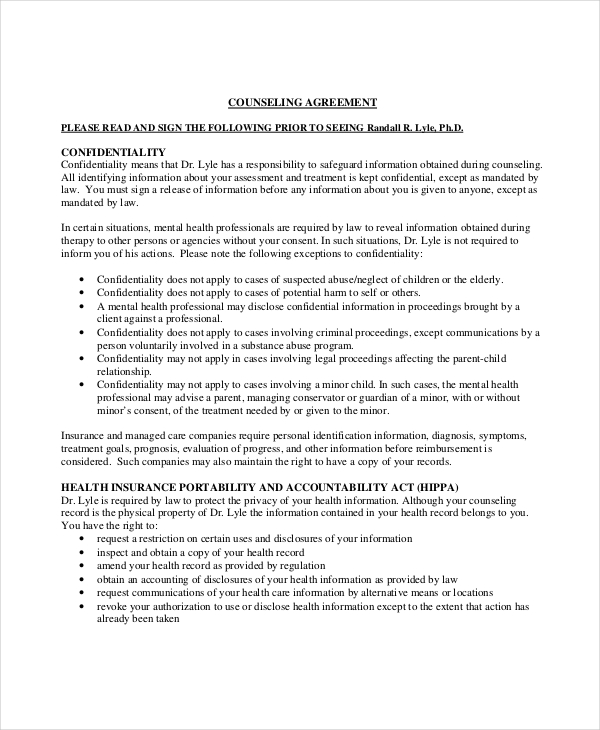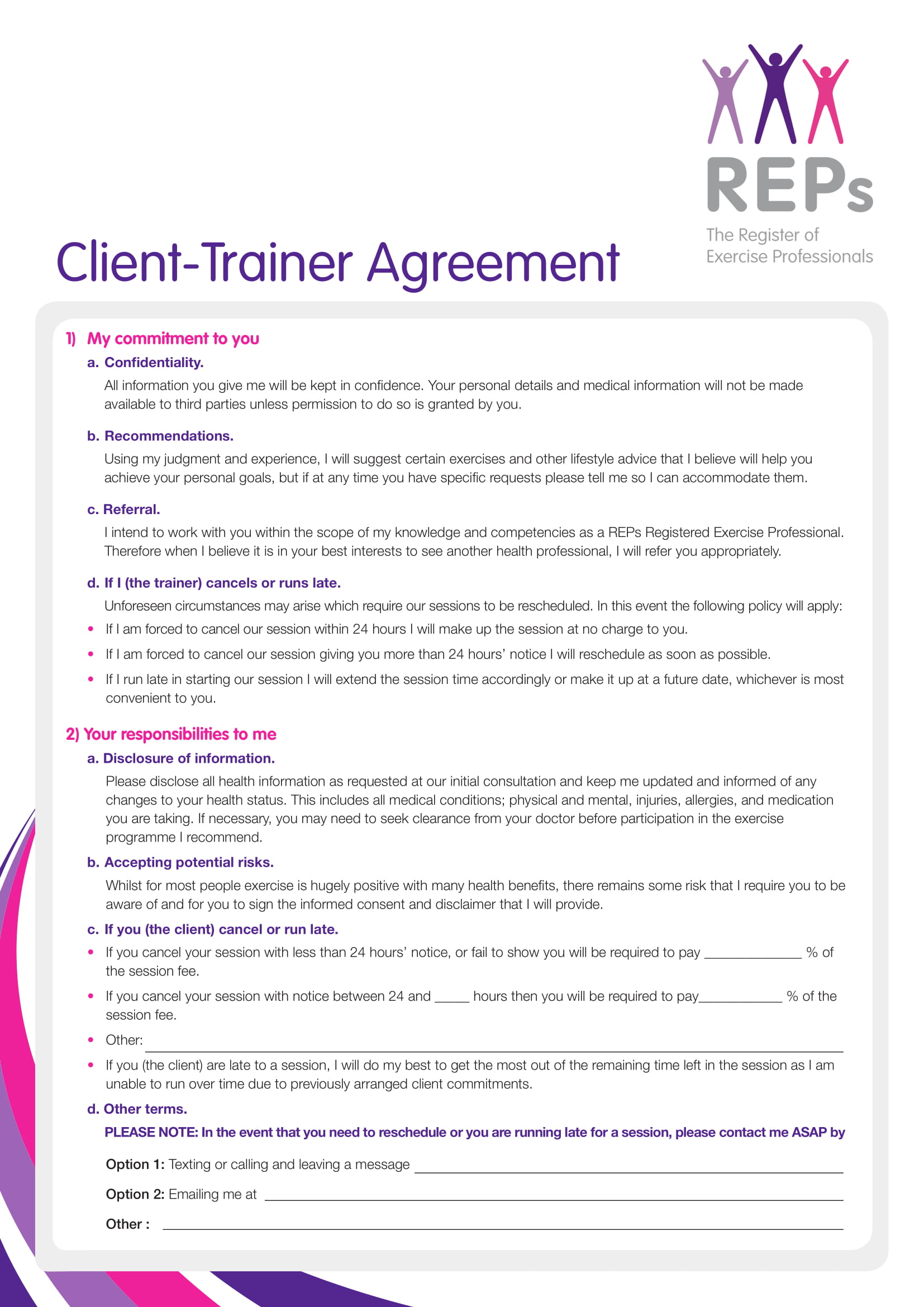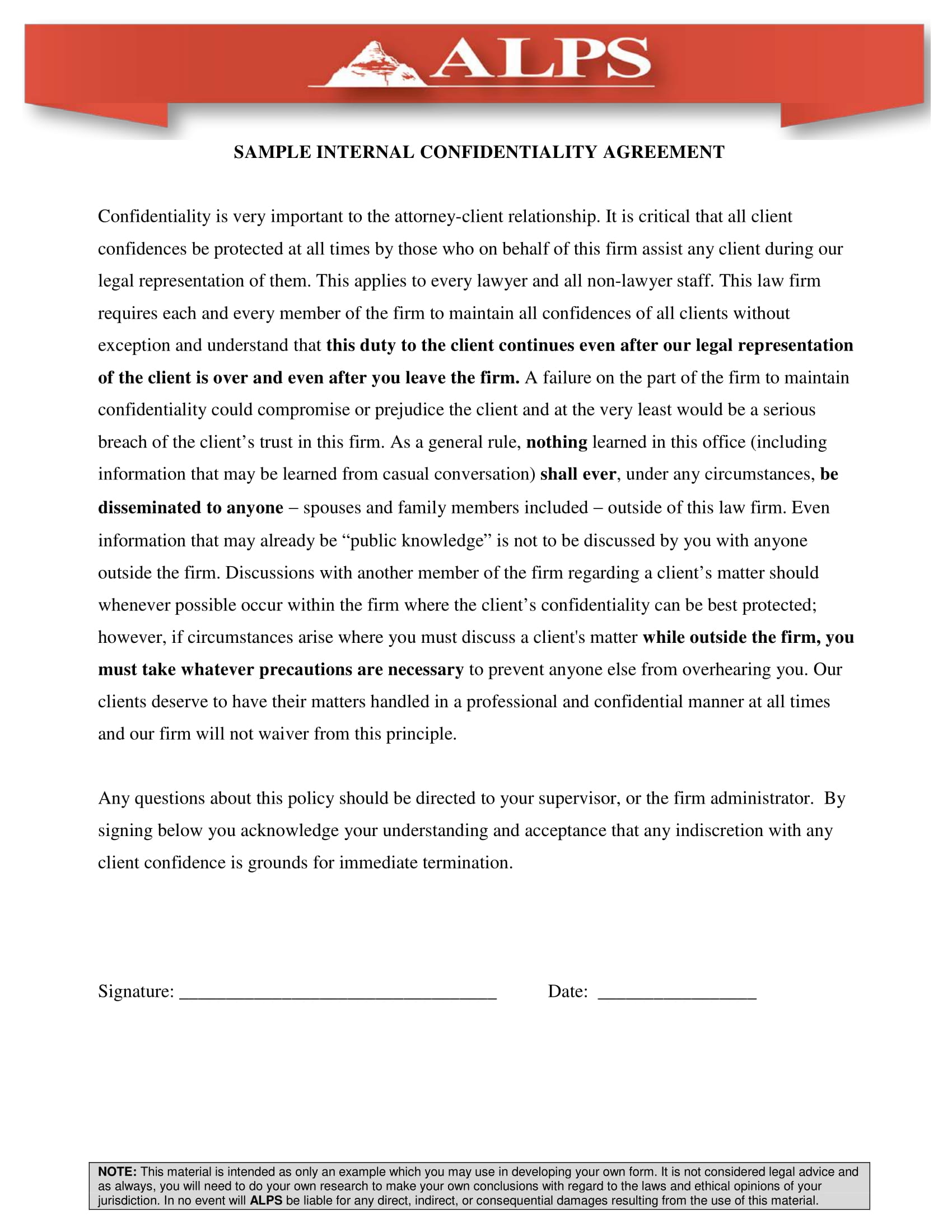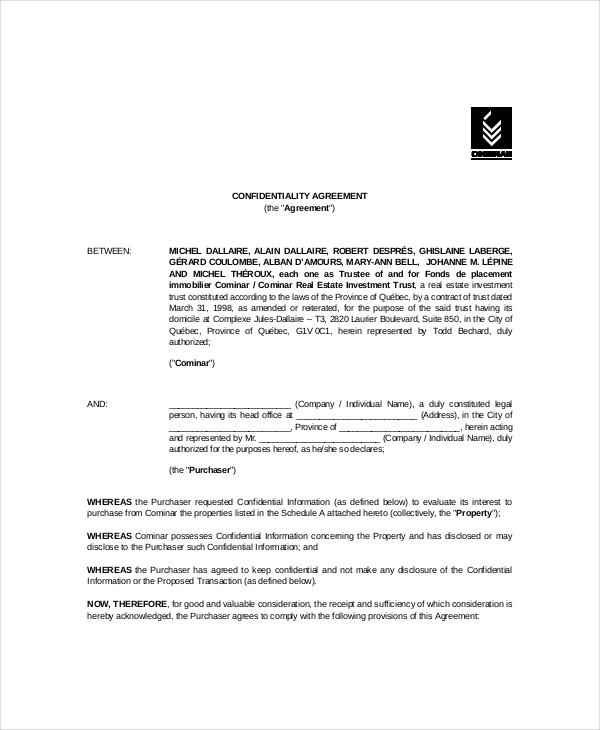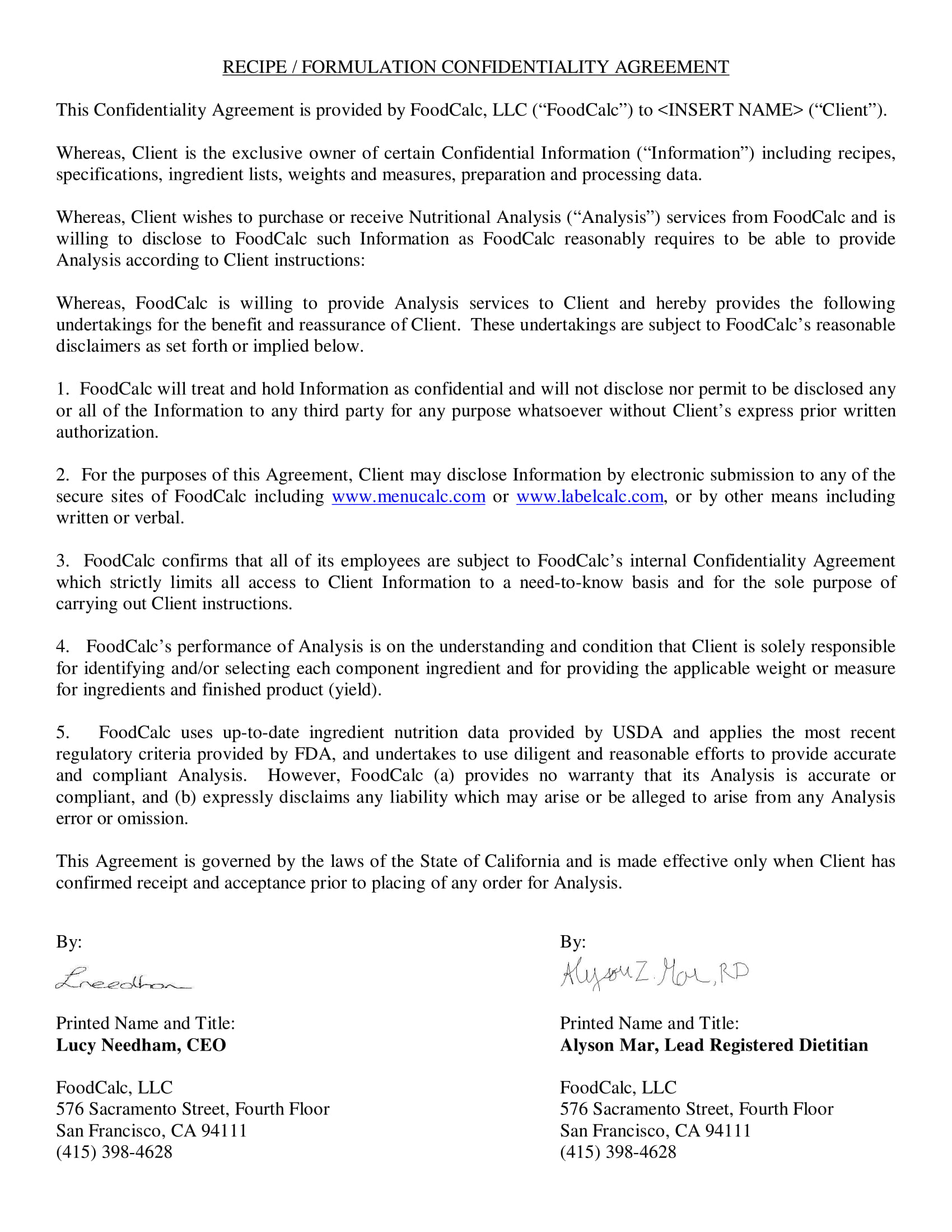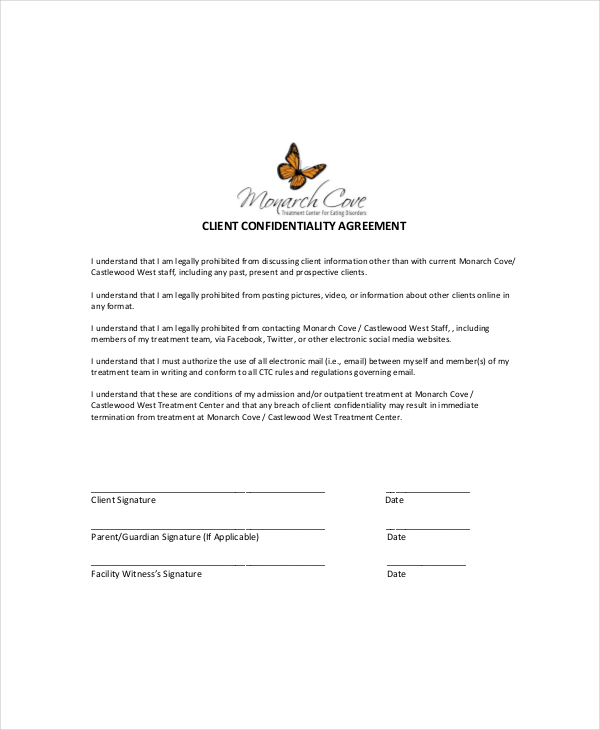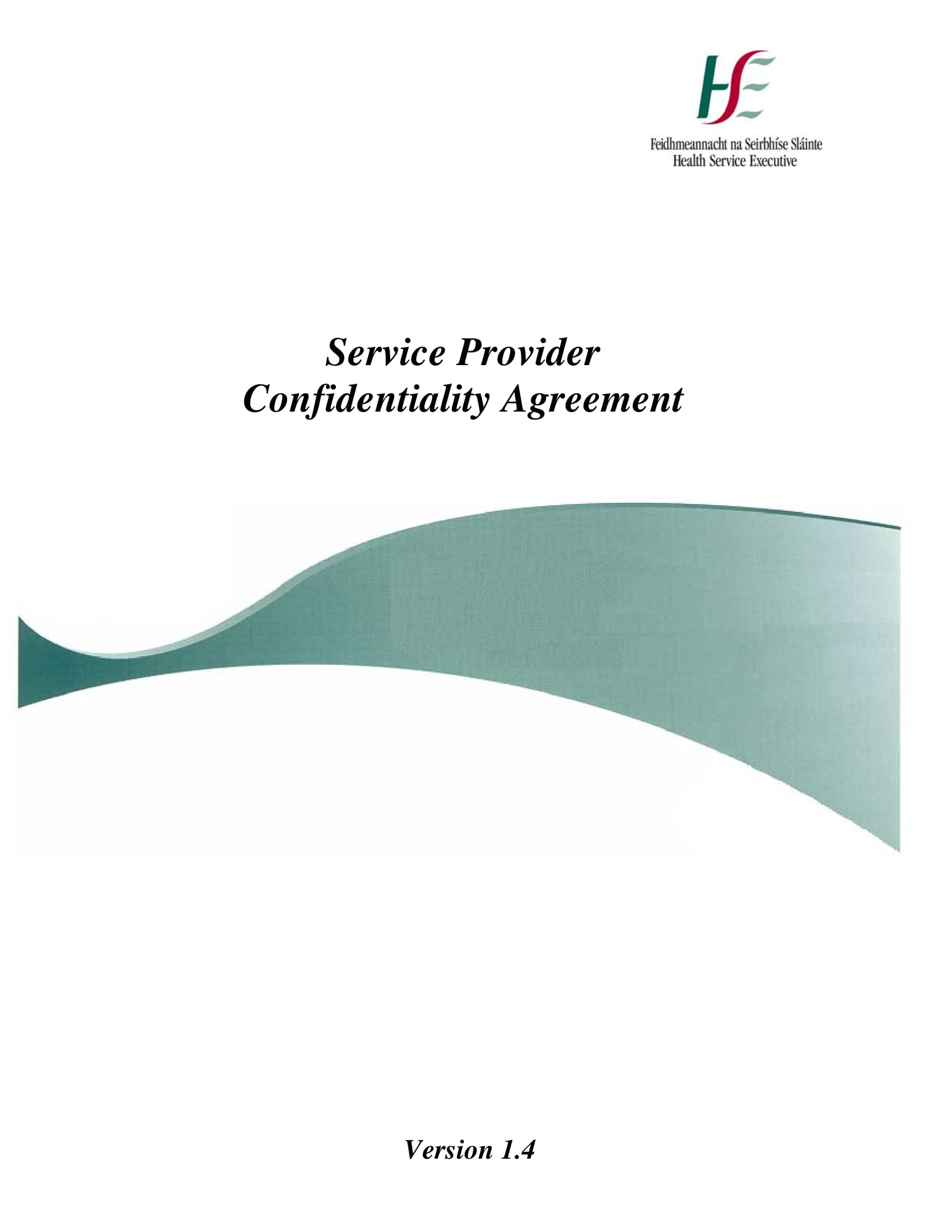10+ Client Confidentiality Agreement Examples to Download
Trust is extremely important in any business-client relationship. With the amount of information and financial resources at stake, clients need to know if they could rely on a company’s services to ensure the success of a given venture. You may also see non-disclosure confidentiality agreement examples.
This is one of the reasons why you should consider having a confidentiality agreement before closing a deal. This can be vital to protect one’s trade secrets, financial information, marketing action plan, and sales strategies, or to simply keep your offers on the down low during the negotiation period.
Client Meeting Confidentiality Agreement Example
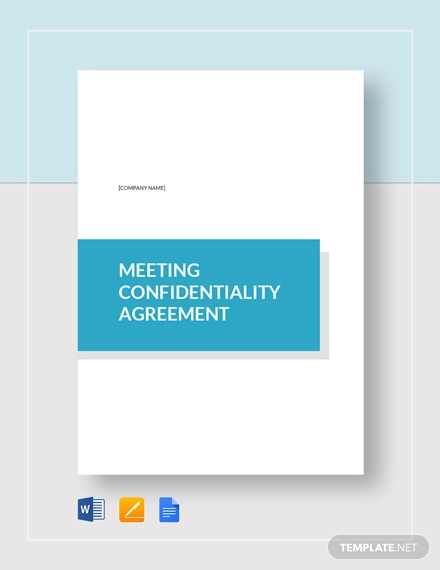
Client Confidentiality Agreement Example
Client Confidentiality Agreement for Physician Example
However, writing a client confidentiality agreement can be a tricky task. So in this article, we discuss the who, what, when, where, how, and why of confidentiality agreements for you to be guided.
Client Confidentiality Agreement Template
What You Need to Know about Client Confidentiality Agreements
Information is usually seen as the most valuable asset a company can have. It is crucial for the organization to manage access to it, and to use legal agreements to protect it from unauthorized disclosure. This often comes in the form of a confidentiality agreement:
1. What Is a Client Confidentiality Agreement?
A confidentiality agreement is a contractual agreement between individuals or businesses (or a combination of both) that is used to protect certain information from being disclosed, including client lists and private data, product development plans, and financial details. Client confidentiality agreements are often requested by clients before consultants are granted the authority to commence work.
A legal agreement such as this provides assurance that the hired individual or company would not release classified information about the client that may be exposed during the interview, consultation process, or contract period. This is also used to control the dissemination of sensitive information by employees or other parties involved in a joint venture. You may also see non-disclosure agreement examples.
A confidentiality agreement comes in two forms, it’s either a one-way simple agreement in which one party discloses confidential information to another party, or a two-way agreement where both parties exchange confidential information with each other.
Once a confidentiality agreement has been signed, the entity receiving sensitive information undertakes the obligation not to reveal what has been described in the document. Otherwise, a breach in contract may lead to serious legal issues for the receiving party. You may also like employee confidentiality agreement examples.
2. Confidentiality Agreements vs. Non-Disclosure Agreements
Confidentiality agreements and non-disclosure agreements are often used interchangeably in the industry. But in practice, there are a few minor differences that separate the two. Though these differences have no impact on the legal effect of either document, there is a slight difference in terms of when they are used.
For instance, a confidentiality agreement is used when a higher degree of secrecy is required. The term “confidential” implies the need to be more proactive in ensuring the protection of sensitive information.
Here, restrictions on the use of classified information are made known, so is the protection of electronic databases, the prevention of employee theft, the need for subcontractors to be bound by the same simple agreement, and other essential components. Non-disclosure, on the other hand, takes a lighter hit on how personal or private information should be handled.
Confidentiality agreements are likely used for multilateral (two-way) exchanges as well. These are frequently used in personal or employment situations, given how many companies often carry potentially damaging information about their employees. On the contrary, non-disclosure agreements are created when the obligation of is unilateral (one-way), especially in third-party or startup situations.
Trade secrets, patent, invention, and intellectual property are just some of the types of information that must be kept a secret by third-party entities such as suppliers, vendors, customers, and contractors.
3. When to Use a Confidentiality Agreement
By default, a confidentiality agreement must be resolved before you disclose valuable information to another entity. In a professional setting, confidentiality agreements are used after resignation, to close a business sale, to settle a divorce, to share financial advice, when firing or terminating an employee, recruiting a new employee, hiring a consultant or contractor, purchasing a business, selling a business, starting a business, and registering patent, just to name a few.
For practicality reasons, you may want to provide the standard confidentiality agreement in advance. The worst thing you can do is catch a person off guard with a 10-page confidentiality agreement that would take an hour or so to fully grasp.
Most confidentiality agreements contain specific and detailed information that must be made known ahead of time to prevent any shortcomings along the way. It’s a good idea to send a copy of the a few days prior to your meeting, and have them prepare a signed copy for you on the day.
4. Why Do Businesses Use Client Confidentiality Agreements?
Given how the primary purpose of a client confidentiality agreement is to keep a client’s most classified information private, a business is likely to request this legal document in order to protect their company as well. This provides assurance that the individual or company would not expose whatever has been shared during the contract period.
5. What Does a Confidentiality Agreement Cover?
There are different types of information that can be protected by a confidentiality agreement. This can be anything from campaign ideas to business plans, financial information to medical records, and even technological inventions to food recipes. They may come in the form of electronic data, written words, software codes, images, oral descriptions, musical notes, and many more.
Keep in mind that for a particular data to be protected as confidential information, there are three conditions that must be met: (1) it should be informed, (2) it needs to be valuable, (3) and it must not be in the public domain. But even then, while these elements may be apparent in one’s general assessment, it may not be in the assessment of others.
There are instances where these elements may not be enough for certain information to be categorized as legally confidential.
Client Confidentiality Counseling Agreement Example
Client-Trainer Confidentiality Agreement Example
Internal Client Confidentiality Agreement Example
Real Estate Client Confidentiality Agreement Example
The Importance of Confidentiality Agreements
Think about it this way. You and your best friend share just about anything to one another. You both know about each other’s hobbies, families, allergies, fears, love interests, past experiences, and other secrets that only somebody that truly cares about you would know. This makes the both of you vulnerable to situations that may threaten your friendship and individual reputations. You may also see staff confidentiality agreement examples.
But because you share a mutual sense of respect, you both agree to never expose each other’s secrets to the public as part of an imaginary agreement.
Similarly, confidentiality agreements are intended to be legally binding. Although you can’t expect it to prevent disclosure in all circumstances, it still limits the risk of a potential disclosure.
A certain degree of transparency is important in any professional relationship. There are times when individuals and organizations need to share vital information with others that must never be revealed for public knowledge. This information could either damage an individual’s reputation or an organization’s image, or leave a negative impact on major deals or simple plans with other prospects.
Failure to use a confidentiality agreement may lead to numerous consequences for all the parties involved, especially for the one providing the information. This gives the receiving party the freedom to do whatever they want with the information that has been supplied to them. They could sell your ideas to competitors, set up their own company using your business ideas, or even broadcast the information on TV and billboards at their own free will. You may also like HIPAA confidentiality agreement examples.
Recipe Client Confidentiality Agreement Example
Rental Client Confidentiality Agreement Example
Service Provider Client Confidentiality Agreement Example
Guidelines for Writing a Confidentiality Agreement
Confidentiality agreements are legal contracts used to protect sensitive information from being exposed to the general public. But because the terms and conditions included in the commercial agreement can greatly affect the course of a business-to-client or business-to-business relationship, producing the document is a crucial task that must be administered with care.
Here are a few things to remember when writing a confidentiality agreement:
1. Don’t rely on templates.
Although agreement templates can come in handy when outlining your content, they aren’t exactly appropriate for every circumstance. It’s important to make an agreement that is specifically tailored according to the nature of your business along with the risks you face. You can use a template as a point of reference in terms of the structure and parts of the document, but make sure to focus on the specifics when it comes to content writing.
2. Consider the need for the agreement.
Ask yourself if you really need a confidentiality agreement in the first place. There’s no point in investing your time and energy on something that has no significance in the situation you are in.
3. Define and specify what is “confidential.”
Be sure to state what you mean by “confidential information,” as this can mean anything to different people. Avoid generalizing your point by providing a clear definition for your formal agreement such as technical information, proprietary ideas, potential new products or services, profits and margin information, financial projections, and trade secrets.
4. State other factors that the agreement covers.
To keep it safe, you also have the option of including a general confidential information clause which indicates that any other information that is disclosed and identified as confidential shall also be protected by this agreement. A narrower approach would be to limit the recipient’s ability to share this information within its own organization, unless they are forced to do so by law. You may also see financial confidentiality agreement examples.
5. Mention how changes should be handled.
Since it is possible for a few minor modifications to occur, be sure to secure a section that explains how the said changes would be reflected in the agreement. The best way to do this is to have the changes written and signed by both parties. You may also like mutual confidentiality agreement examples.
6. Add a severance provision.
A severance provision indicates that if there are any clauses within the document that are found to be non-enforceable, then they will not affect the enforceability of the rest of the agreement.
7. No special rights.
Nobody from either party should be granted immunity from what has been stated in the agreement. Special rights to key information should be prohibited, and must be clarified clearly in another clause.
8. No purchasing rights.
It’s advisable to add a clause that states how the simple confidentiality agreement does not place either party under a particular obligation. You need to be perfectly clear with this clause to avoid further problems.
9. Permitted use.
Agreements can come in all different forms, depending on its specific function. But since this document is specifically made to keep certain information protected, make sure to explain that the only permitted use of the confidential information is for the purpose for which it was disclosed. You may also check out mutual confidentiality agreement examples.
10. Remedies.
If one party has accidentally (or even intentionally) revealed the confidential information, the agreement must define the remedies that would be granted to the party who may suffer as a result of the other party’s carelessness. This is usually settled through monetary compensations or damages. You might be interested in audit confidentiality agreement examples.
However, in some cases, it might be more suitable to push for an injunction. This is used to prevent parties from continuing to disclose the information for as long as the agreement is in effect.
Sharing sensitive personal or business information with another entity can be a risky move. It’s a nerve-wracking experience that could lead to numerous consequences when approached poorly. Failing to protect yourself can lead to several minor and major damages that can be fairly difficult to reverse. Hence, many professionals strongly suggest the use of a confidentiality agreement for the benefit of all. You may also see medical confidentiality agreement examples.
A client confidentiality agreement ensures the protection from private information being disclosed to an unauthorized entity without proper consent. Signing the said agreement must be done with precaution to avoid further issues as well.
So if you find yourself in need of a client confidentiality agreement, make sure to use these guidelines and examples as reference.



